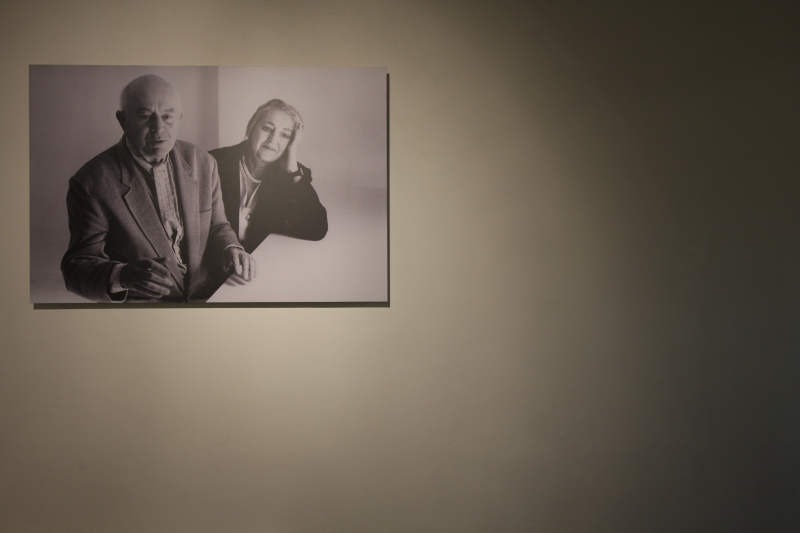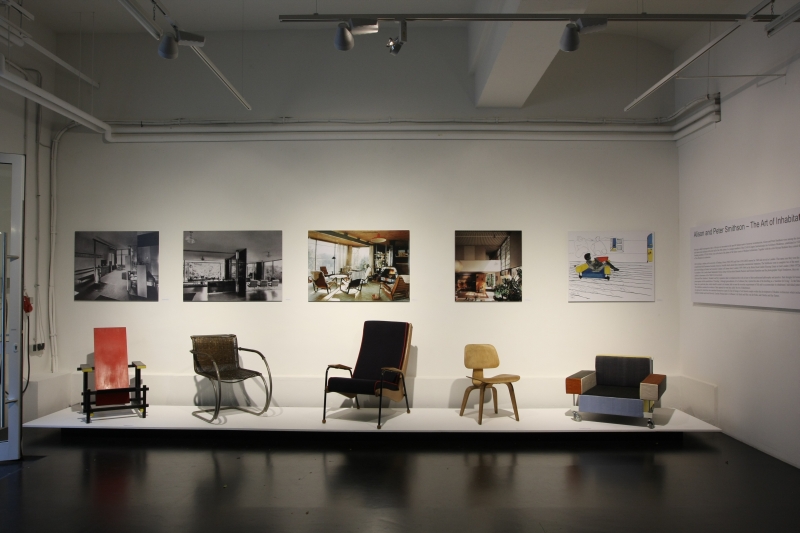We’re almost too late, almost, but until November 8th the AIT ArchitekturSalon Cologne is presenting the exhibition, Alison and Peter Smithson – The Art of Inhabitation.
A reworked version of the London Design Museum’s 2003 exhibition “Alison and Peter Smithson – From the House of the Future to a House of Today”, “The Art of Inhabitation” explores the work and legacy of two of the most important post-war British architects through just one facet of the extensive canon: private houses.
A facet of their work that although central to their actual, realised, output plays in most people’s perception of the pair second fiddle to their theoretical output and their defining role in the establishment of Brutalism as an architectural genre.

Alison Gill and Peter Smithson met while studying architecture at University of Durham, Newcastle-upon-Tyne. In 1949 the pair married and in the same year won their first major commission, the Secondary Modern School in Hunstanton: a project that caused a great stir at the time and can, with its swathes of glass and strict, self confident yet somehow intrinsically fragile form, be considered the first truly Brutalist construction. As members of the Congrès international d’architecture moderne, CIAM, Alison and Peter Smithson participated in numerous congresses before in 1953 they joined forces with a group of like-minded contemporaries to establish the so-called “Team 10″, a collective of young architects unhappy with the way the “old guard” (our words not theirs) were leading the Modernist movement and keen for change. Ultimately the resistance of Team 10 to the ideas of leading CIAM members such as Le Corbusier saw the demise of the CIAM. And so the end of a formal, structured, organisation of Modernism.
A story which although apparently tragic, fits nicely with a central component of Alison and Peter Smithson’s understanding of Modernist architecture: the concept of the three generations.
In the Smithson’s theory the development of the Italian Renaissance can be seen as progression over three generations, starting with Filippo Brunelleschi (1377-1446) before moving over Leon Battista Alberti (1404-1472) and on to Francesco di Giorgio (1439-1501).
“Through these three men ran the mainstream of the Renaissance, a span of three generations for the invention and the spread into ordinary use of a language whose intentions were wholly new”, as the Smithsons so poetically phrase it.
Similarly the development of Modernism, according to Alison and Peter Smithson, began with Walter Gropius, Ludwig Mies van der Rohe and Le Corbusier moved over a second generation as exemplified by Jean Prouvé or Charles Eames and then reached a third generation, a generation that included Alison and Peter Smithson themselves.
Just as with the Italian Renaissance the younger generation did not simply copy the older, but inherited their experience and ideas which they then used as a theoretical foundation on which to develop their own ideas.
Recalling, for example, a Mies van der Rohe exhibition held at the New York Museum of Modern Art in 1947 Peter Smithson says “… what was unknown to me until quite recently was that Eames photographed the exhibition, which was the trigger, in my view, that made him change the design of his own house from a bridge-like design to the house on the ground. This was the beginning of an American link. Eames was an inheritor of a notion.”
And in many ways the title of the exhibition is reference to an idea of a notion the Smithson’s inherited from Charles and Ray Eames.
Much as the Eames’ interior style was dominated by the concept of the Collage – a concept that can briefly be described as everything fits together if you want it to – so was the Smithson’s approach defined by the phrase “dressing by the art of inhabitation”, a process that allows the user to create the space they want and in a way that suits their individual, personal, emotional requirements. And which therefore stands in deliberate and direct contrast to Le Corbusier and his idea of the house as a “living machine.”
Once you understand this, you understand the Eames Collage as a less direct challenge to the Le Corbusier diktat. And so the progression from Le Corbusier to Alison and Peter Smithson via Charles and Ray Eames.
Three generations.
And the inclusion of Ray Eames and Alison Smithson in the above paragraph is important, for unlike the development of the Renaissance the development of Modernism had an unmistakable feminine accent: Lily Reich with Mies van der Rohe, Truus Schröder-Rietveld with Gerrit Rietveld, Charlotte Perriand with Le Corbusier, and most influential of all for the Smithson’s, Ray Eames with Charles Eames.
Alison and Peter Smithson – The Art of Inhabitation opens with examples of furniture from these three Modernist generations before moving on to look at domestic projects developed by Alison and Peter Smithson, both houses and also exhibitions the pair curated including the 1956 shows “Patio and Pavilion” and “House of the Future”. A further section presents examples of the pairs, extensive, writings.

A particularly interesting moment is the final part of the exhibition which is devoted to the pairs relationship with Axel Bruchhäuser, owner and director of German furniture manufacturer TECTA.
Throughout the 1980s and 1990s Alison and Peter Smithson completed numerous architectural projects for Axel Bruchhäuser including the Kragstuhl Museum at the TECTA HQ in Lauenförde, and the so-called Hexenhaus, a private house for Axel Bruchhäuser in Bad Karlshafen - a deliciously monstrous project whose full majesty can only be vaguely guessed at despite being presented in photos, sketches, and most impressively, a scale model that dominates the final part of the Cologne exhibition space.
In addition to architecture Alison and Peter Smithson also developed a number of furniture prototypes for TECTA, furniture which although present in Cologne is, thankfully, given less priority in the exhibition design. For while the Robin Chair is a formal joy, the Collectors Table and the lilac coffee table whose name we forgot to note, are probably best left being just curiosities of mildly over enthusiastic imaginations. And in that respect it is slightly disappointing that there are no examples of the truly charming furniture the pair created for the 1956 “Home of the Future” exhibition, furniture with its exotic sounding names like “Egg” and “Tulip”.
And yes they were created and named before the works of Messers Jacobsen and Saarinen.
Despite this, in our opinion, less than optimal presentation of the pair's furniture creations The Art of Inhabitation provides an excellent overview of Alison and Peter Smithson, their progression, their philosophies, their creativity and their energy, which succinctly brings home just how important they were and relevant they are.
What the exhibition also does very well is clarify what Brutalism is. If your perception of Brutalism is buildings such as James Goldfinger’s Trellick Tower in London, Louis Kahn’s National Assembly Building in Dhaka, Bangladesh or Le Corbusier’s Unité d’Habitation in Marseille, then a visit to the AIT ArchitekturSalon Cologne is to be recommended.
In its original idea, if one can speak of such, Brutalism was about of getting back to roots, almost vernacular in its authenticity, it was about making the elements and components of a building visible. A definition which of course makes even the SANAA Factory Building for Vitra Brutalist.
Architecture exhibitions can be daunting prospects. Threatening as they invariably do to overpower the unwary visitor in a maelstrom of technical drawings and even more technical jargon.
Alison and Peter Smithson – The Art of Inhabitation avoids such hazards, and while the technical sketches are there if you want or need them, the exhibition curators rely much more on models and simple texts to explain the individual projects, their context and their role in Alison and Peter Smithson’s canon. A curatorial decision that makes Alison and Peter Smithson – The Art of Inhabitation as accessible as it is entertaining.
Alison and Peter Smithson – The Art of Inhabitation can be viewed at the AIT ArchitekturSalon Cologne, Vogelsanger Strasse 70, Barthonia Forum, 50823 Cologne until Friday November 8th 2013.
If you can get along. You should.
A few impressions.